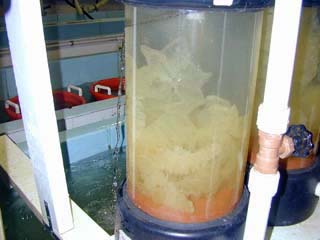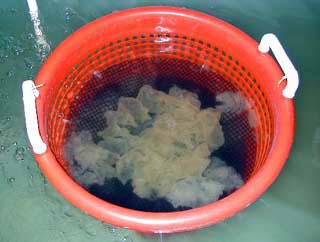
Yellow perch stocks in many rivers systems in Maryland's portion of the
Chesapeake Bay have declined in recent decades. Rigorous assessment of aquatic
habitat health from an ecosystem approach is emerging as a new technique to
manage resources. Changes in habitat quality and quantity caused by human
impacts are likely to be responsible for at least some declines of aquatic organisms.
In particular, impacts that diminish water quality in the watershed can reduce
survival during critical life history stages and thus, reduce abundance.
Evaluation of survival of egg and larval, juvenile, sub adult and adult fish
can be used to determine factors that limit stock abundance.
Stocking
marked fish can also be used to collect valuable stock assessment information
from the population. Many commonly employed mark-recapture strategies employed
in fisheries management lend themselves to this type of assessment. Stocking
multiple sizes and ages of fish (larval, juvenile) enables evaluation of
survival for these life stages. Survival can be affected by specific habitat
and water quality variables. These data can be used to evaluate impediments to
recruitment caused by degraded water quality or the environment. Learning how
human-induced changes affect recruitment to the population can focus mitigation
attention to remedy adverse impacts and improve the habitat.
Past Yellow Perch Restoration Efforts, 2001-2005

Selection of
tributaries that could benefit from restoration is critical. The tributary must
have once had suitable habitat to support the various life history stages of
the organism. Selection should be based on historic and current data on the
status of the population. In the early 2000s, two rivers that met these
criteria were the Severn River and South River. These rivers once supported
abundant populations of yellow perch. Historical scientific information on the
populations exist and surveys were conducted to document the occurrence of
perch in these rivers. Development has been heavy in these watersheds, which
significantly affects water quality and habitat. Evaluation of the quality and
potential productivity in these developed watersheds was valuable to develop an
approach to managing aquatic resources and fish populations.
Maryland Department
of Natural Resources Fish Health and Hatcheries Program conducted a pilot
project for restoration of Severn River and South River yellow perch during the
spring of 2001. This included the development of reliable production and
marking techniques to produce fish for stocking and to assess the impacts of
stocking efforts. Techniques included induced spawning of adult yellow perch
using hormonal stimulation, oxytetracycline marking trials to determine optimal
doses for effective marking, cultivation of perch of several ages and sizes for
stocking, and development of methods to uniquely mark fish stocked at different
sizes. In order to enhance and evaluate river ecosystems we initiated a three-year
stocking program in 2002. Pre-spawned adults were collected from fyke nets set
in targeted tributaries. Adults were transported to the state’s Joseph Manning
Hatchery and induced to spawn in tanks. Perch were marked and stocked as larvae
and juveniles in the Severn River and South River. Approximately 600,000 larvae
and 400,000 juveniles were released into these tributaries.
A monitoring
program was conducted in both watersheds to collect yellow perch. Sampling was
conducted over the range of occurrence for juveniles immediately following each
stocking event. Approximately 450 yellow perch that were captured in the survey
were analyzed to determine hatchery or natural origin. Results indicated that
the hatchery fish had good survival up to juvenile size. The contribution of
wild perch and those stocked as larvae and juveniles was used to determine
parameters, such as survival and abundance, using mark-recapture models. These
sampling efforts were useful to assess the population status in these rivers
and evaluate the watershed ecosystem health.
Results
of the investigation indicated that the major impediments to successful yellow perch
populations on the Severn and South rivers are poor recruitment and low
juvenile indices. This is due the associations of impervious surface and
development with yellow perch health and spawning success. Until these issues
are addressed, the success of corrective stocking will be limited. 2005 was the
last year that the Fish Health and Hatcheries Program stocked yellow perch in the
Severn River and South River.
Current Yellow Perch Restoration
Efforts, 2015 - present
Due to
concerns with declining spawning runs and reduced yellow perch populations in
some historically productive fishing locations in Southern Maryland, the
department decided to supplement wild populations with hatchery produced fish.
Stocking efforts are intended to contribute positive impacts to reduced or declining
fish populations. Yellow perch egg chains are acquired from tributaries with
healthy populations and transported to the Manning State Hatchery to be
cultured and marked prior to stocking. Since 2015, more than 50,000 juvenile yellow
perch have been stocked into Allens Fresh, a tributary of the Wicomico River in
Charles County. Yellow perch stocking can be used to enhance fish populations
and improve angling opportunities. Stocking into Allens Fresh will continue as
the department evaluates the impacts of stock enhancement efforts on the local yellow
perch population.